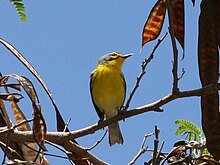Adelaide's warbler
| Adelaide's warbler | |
|---|---|

| |
| Scientific classification | |
| Domain: | Eukaryota |
| Kingdom: | Animalia |
| Phylum: | Chordata |
| Class: | Aves |
| Order: | Passeriformes |
| Family: | Parulidae |
| Genus: | Setophaga |
| Species: | S. adelaidae
|
| Binomial name | |
| Setophaga adelaidae (Baird, 1865)
| |

| |
| Synonyms | |
|
Dendroica adelaidae Baird, 1865 | |
Adelaide's warbler (Setophaga adelaidae) is a
Description
The S. adelaidae complex was originally considered a single species, with three populations occurring in
In 2011, the American Ornithologists' Union reclassified the Parulidae, which resulted in D. adelaidae being transferred to genus Setophaga.[5]
Adelaide's warbler has gray upperparts with yellow underparts. The species has a yellow line above the eye and a white half-moon below it. Its average length is 12 cm (4.7 in) and its average weight is 7 g (0.25 oz).
Adelaide's warbler occurs in the main island of Puerto Rico and in the island municipality of Vieques. The species occurs mainly in dry forests in the southern region of Puerto Rico such as the Guánica State Forest, with some occurrences in the northern moist forests and the central mountain range, Cordillera Central.
Adelaide's warbler is an
. Adelaide's warblers build nests at heights of 1 to 7 m in which the female deposits anywhere from 2 to 4 white eggs. The eggshells usually have small brown spots.| External audio | |
|---|---|
| Bird Call | |
See also
- Fauna of Puerto Rico
- List of birds of Puerto Rico
- List of endemic fauna of Puerto Rico
- List of Puerto Rican birds
- List of Vieques birds
- El Toro Wilderness
References
- . Retrieved 12 November 2021.
- ISBN 978-1-4729-8269-8.
- ^ Sellers, Edwin Jaquett (1897). Genealogy of the Kollock Family of Sussex County, Delaware, 1657-1897. Press of J.B. Lippincott Company.
- JSTOR 4088856.
- S2CID 13691956.
Further reading
- "Adelaide's Warbler – Dendroica Adelaidae". Oiseaux.net. Archived from the original on 7 March 2006. Retrieved April 7, 2006.
- (in Spanish) Sociedad Ortinológica Puertorriqueña – Reinita Mariposera
- Oberle, Mark (2003). Las aves de Puerto Rico en fotografías (in Spanish). Editorial Humanitas. ISBN 0-9650104-2-2.

